
Drinker moth caterpillar ©Tom Marshall
How to identify caterpillars
What is a caterpillar?
A caterpillar is the larval stage of a moth or butterfly. It is the second part of their four-stage life cycle (egg, larva, pupa, adult). Caterpillars have long, worm-like bodies with six true legs. They can also have a variable number of stumpy false legs (called prolegs), which help them to move and cling to things.
Caterpillars can change dramatically from when they first hatch to when they're ready to pupate. Some can increase their body mass 10,000-fold in just a few weeks - that's like a baby growing to the size of a sperm whale! Many look very different as they grow, so we've described the larger stages of the caterpillar's growth, when they're often more obvious.
Which caterpillars am I likely to see?
Many of these caterpillars are most obvious when they're fully grown and looking for a place to either pupate or settle down for the winter, though some are easily spotted on their favourite food plants. Here are some of the species we're most frequently asked to identify.
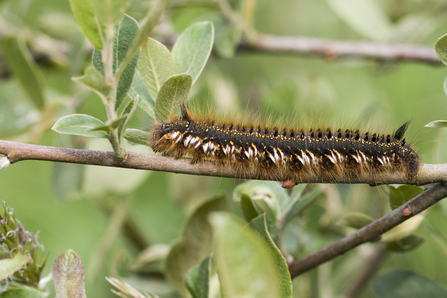
Drinker moth caterpillar ©Chris Lawrence
Drinker moth
When & where: August-June. A variety of habitats including gardens, but especially damp grassland, marshes and boggy areas.
Description: Up to 7 cm long. Dark and covered with brown hairs and golden speckles. A row of white hairs runs down each side of the body.
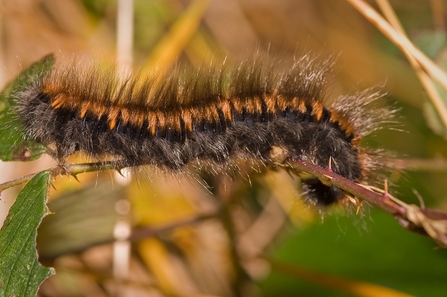
Fox moth caterpillar ©David Longshaw
Fox moth
When & where: June-April, most obvious in spring. Common habitats include heathland and coastal grassland.
Description: Up to 7 cm long. Hairy, with long dark hairs on the sides of the body and shorter orange hairs on top. Young caterpillars are dark with orange bands.
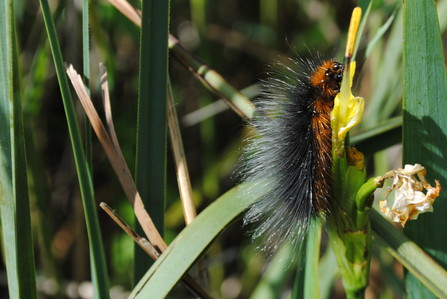
Garden tiger caterpillar ©Amy Lewis
Garden tiger
When & where: August-June. A wide range of habitats including gardens.
Description: Up to 6 cm long. An extremely hairy caterpillar, known as the "woolly bear". Mostly black and ginger, with longer white hairs.
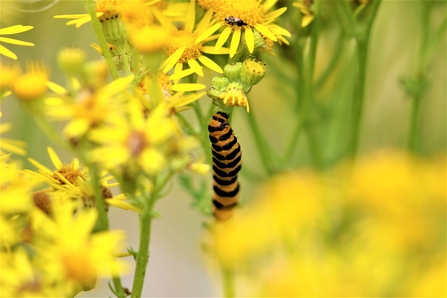
Cinnabar moth caterpillar ©Andrew Hankinson
Cinnabar
When & where: July-September. Found on ragwort in most grassy habitats.
Description: The caterpillars of this moth are distinctive, with black and yellow stripes - warning predators that they taste terrible. They're easily spotted feeding on ragwort.
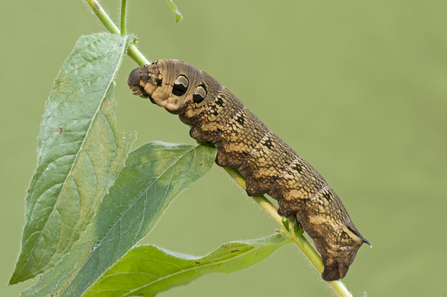
Elephant hawk-moth caterpillar ©Dawn Monrose
Elephant hawk-moth
When & where: June-September. A variety of habitats, including gardens. Often where rosebay willowherb is found.
Description: Up to 8.5 cm long. A chunky green or brown caterpillar, with several eyespots at the front end and a spiky 'tail' at the rear.
Privet hawk-moth caterpillar ©Roy Bedborough
Privet hawk-moth caterpillar
When & where: July to September. Widespread in southern England and Wales. Found in a variety of habitats, including gardens.
Description: Up to 8.5cm long. Green and chunky, with purple and white stripes on the body and a black and yellow horn on the rear.
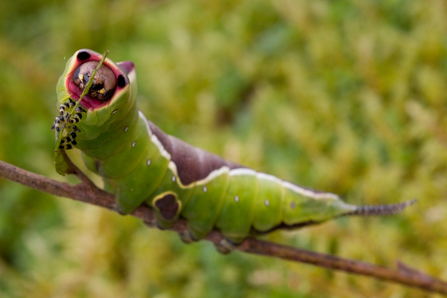
Puss moth caterpillar ©Vaughn Matthews
Puss moth caterpillar
When & where: June to September. Widespread in a variety of habitats, including parks, gardens and wetlands.
Description: A plump, green caterpillar with a dark, white-edged 'saddle'. The head is surrounded by a pink patch, with false eyes making it look like a giant face. There are two thin tails.
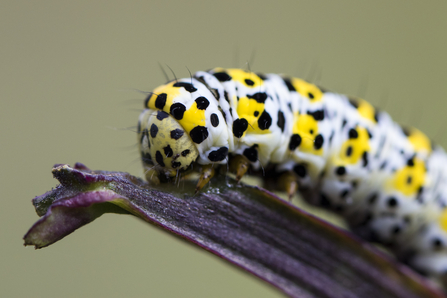
Mullein moth caterpillar ©Chris Lawrence
Mullein moth
When & where: April-July. A range of open habitats, including gardens. Feeds on mulleins and buddleia.
Description: Distinctive whitish caterpillars, with horizontal yellow splodges across the body and large black spots.
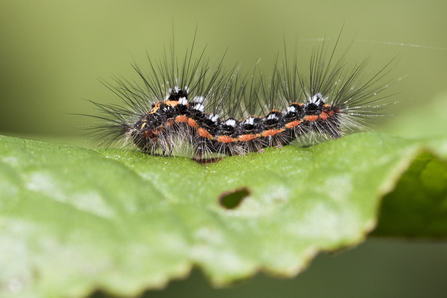
Yellow-tail moth caterpillar ©Chris Lawrence
Yellow-tail
When & where: August-June. Scrubby habitats including hedgerows, woodland and gardens.
Description: Black with long, greyish-white hairs. On top it has a pair of red lines, with a row of white blotches either side of them. A red line runs along each side. The hairs can be an irritant.
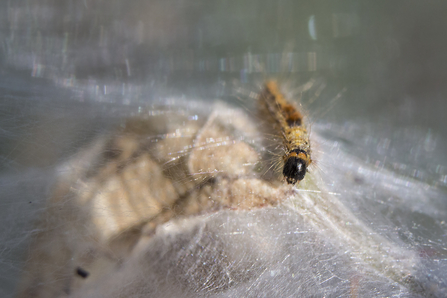
Brown-tail moth caterpillar ©Chris Lawrence
Brown-tail
When & where: August-May. Scrubby habitats, including coastal scrub.
Description: Black with long brown hairs, red spots on top and a line of white marks along each side. Found in conspicuous communal webs on food plants. The hairs cause skin irritation. (Younger caterpillar pictured)
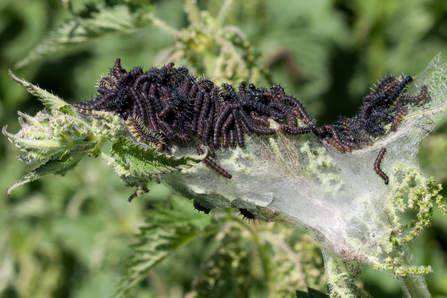
Peacock caterpillars ©Vaughn Matthews
Peacock
When & where: May-July. Common in a range of habitats where common nettle is present.
Description: Up to 4.5 cm. Black with black spines and small white dots. Found in communal webs on common nettles.
Vapourer moth caterpillar ©Tom Hibbert
Vapourer
When & where: May-September. Commonly found in a variety of habitats including woodland, parks and gardens.
Description: A funky-looking grey and black caterpillar, with large tufts of hair, including a mohawk of yellow tufts on the back. Large caterpillars can often be spotted in late summer on a range of shrubs and trees.
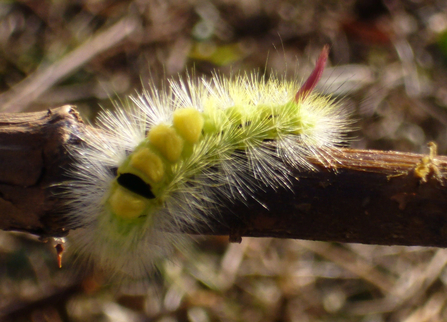
Pale tussock caterpillar ©Lizzie Wilberforce
Pale Tussock
When & where: June-October. Found on a wide variety of deciduous trees and other plants, including bramble.
Description: A striking bright green caterpillar, with black bands between its body segments, yellow/whitish hairs, a row of yellow tufts on top and a red tuft at the rear.
Not a caterpillar!
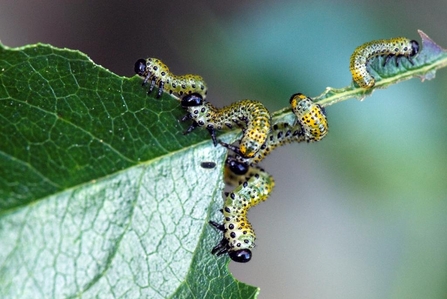
Rose sawfly larvae ©Les Binns
Sawfly larvae
Sawflies are a group of flies, whose larvae look very similar to caterpillars. The larvae are usually 1-4 cm long, but come in an impressive variety of colours. One way to spot a sawfly larva is to count the legs - they also have six true legs, but usually have six or more pairs of the stumpy 'prologs', whereas caterpillars have five or fewer.
Would you like to help make a real difference to the wildlife in London?
